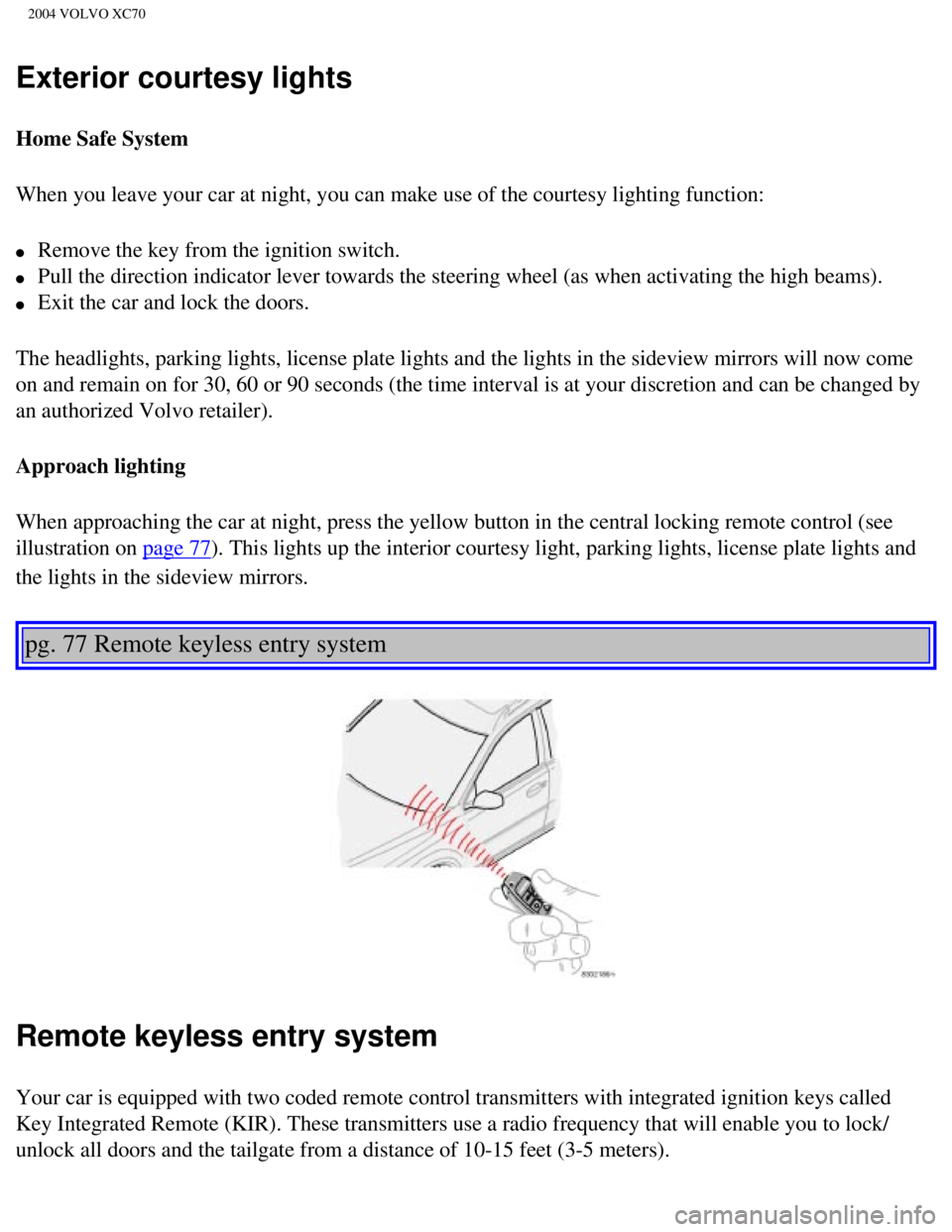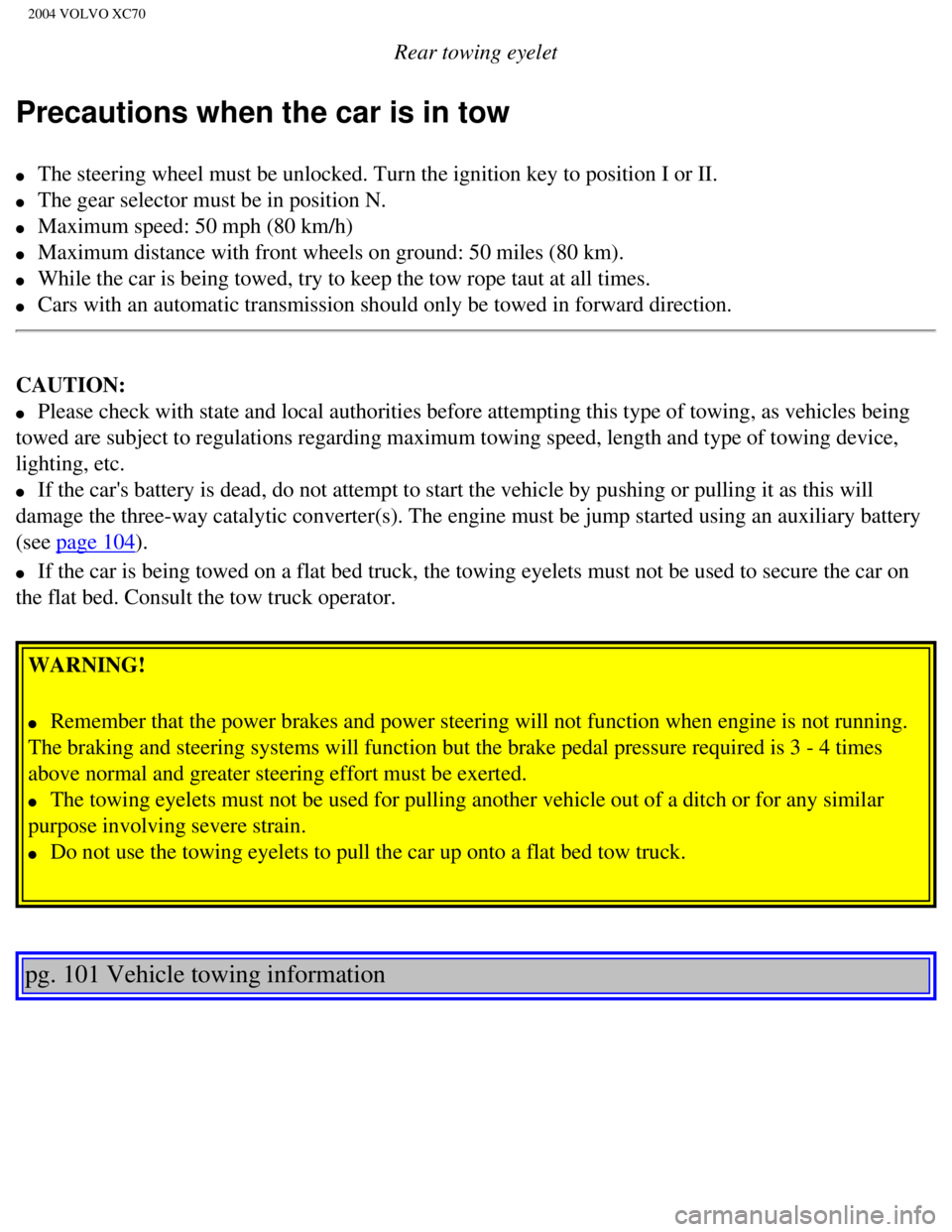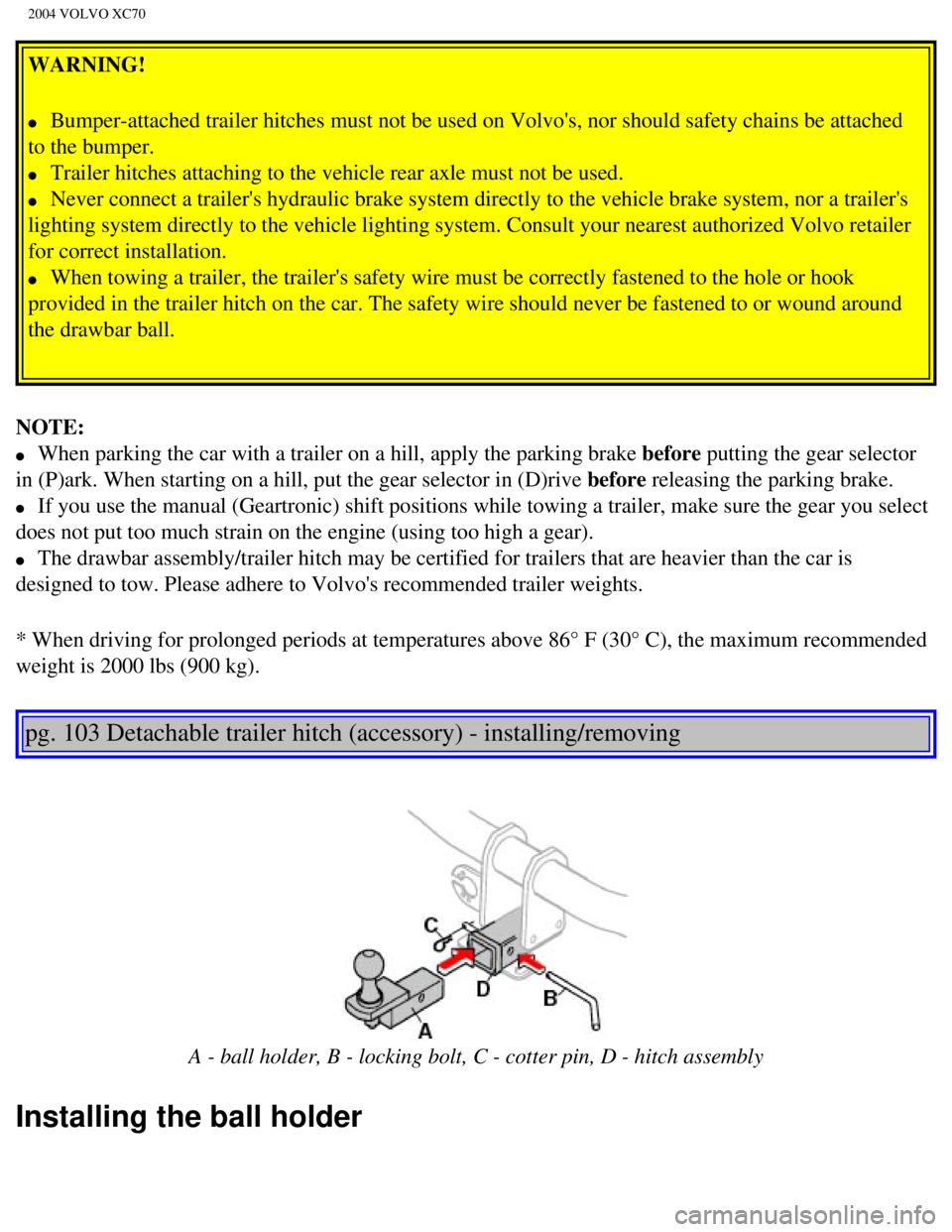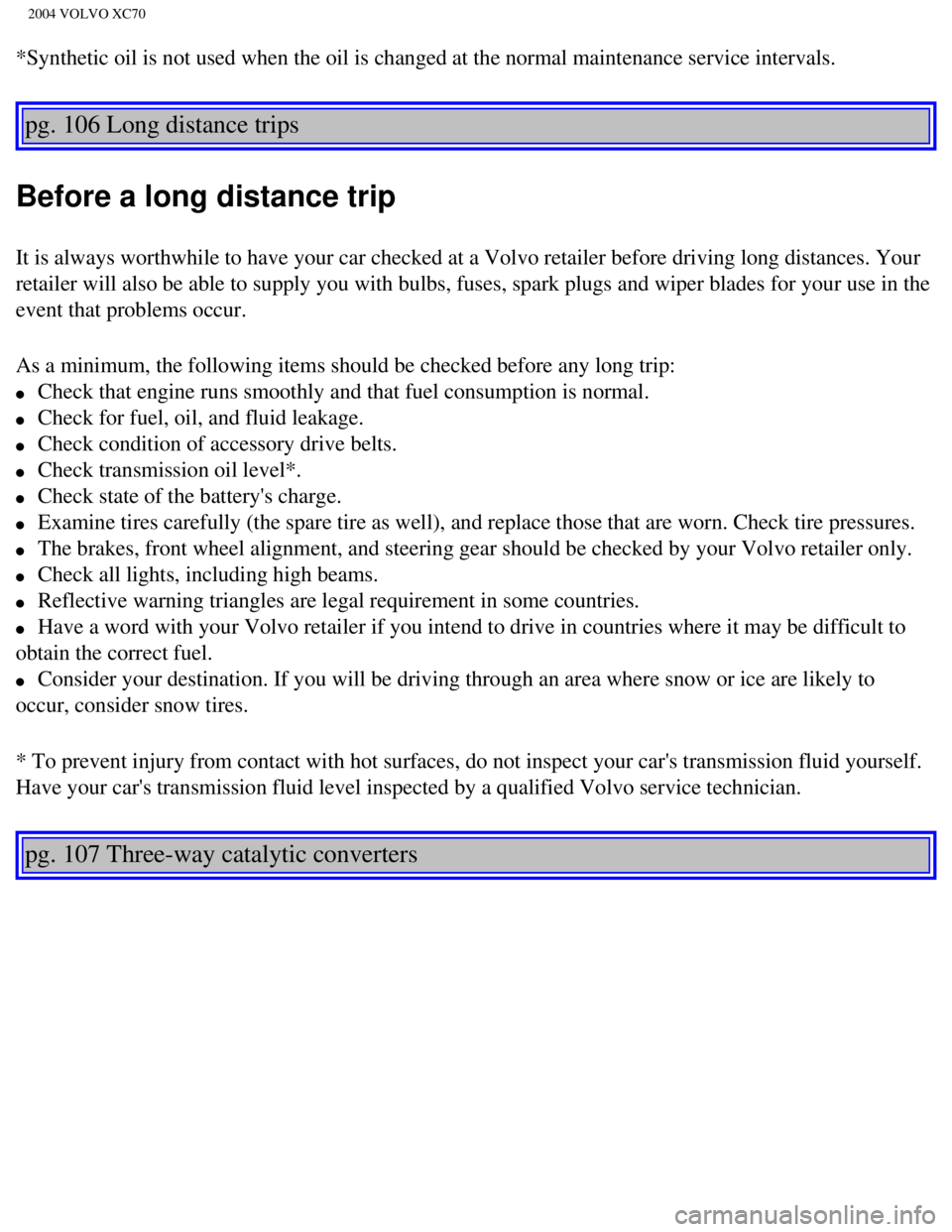light VOLVO XC70 2004 Workshop Manual
[x] Cancel search | Manufacturer: VOLVO, Model Year: 2004, Model line: XC70, Model: VOLVO XC70 2004Pages: 241, PDF Size: 5.78 MB
Page 115 of 241

2004 VOLVO XC70
2 0 0 4
VOLVO XC70
Chapter 5 - Keys, Locks, Alarm
pg.75 Keys, Locks, Alarm
Keys, Exterior courtesy lights, Locking and unlocking the
car 76
Remote keyless entry system 77
Unlocking the tailgate, Central locking buttons 79
Alarm 80
Child safety locks - rear doors 82
pg. 76 Keys, Exterior courtesy lights, Locking and unlocking the car
Keys
file:///K|/ownersdocs/2004/2004_XC70/04xc70_05.htm (1 of 11)12/30/2006\
4:33:01 PM
Page 117 of 241

2004 VOLVO XC70
Exterior courtesy lights
Home Safe System
When you leave your car at night, you can make use of the courtesy light\
ing function:
l Remove the key from the ignition switch.
l Pull the direction indicator lever towards the steering wheel (as when \
activating the high beams).
l Exit the car and lock the doors.
The headlights, parking lights, license plate lights and the lights in t\
he sideview mirrors will now come
on and remain on for 30, 60 or 90 seconds (the time interval is at your\
discretion and can be changed by
an authorized Volvo retailer).
Approach lighting
When approaching the car at night, press the yellow button in the centra\
l locking remote control (see
illustration on
page 77). This lights up the interior courtesy light, parking lights, license \
plate lights and
the lights in the sideview mirrors.
pg. 77 Remote keyless entry system
Remote keyless entry system
Your car is equipped with two coded remote control transmitters with int\
egrated ignition keys called
Key Integrated Remote (KIR). These transmitters use a radio frequency \
that will enable you to lock/
unlock all doors and the tailgate from a distance of 10-15 feet (3-5 me\
ters).
file:///K|/ownersdocs/2004/2004_XC70/04xc70_05.htm (3 of 11)12/30/2006\
4:33:01 PM
Page 118 of 241

2004 VOLVO XC70
The transmitters will also activate or allow "keyless" entry into the pa\
ssenger compartment or the
tailgate. They will also activate or deactivate the vehicle's alarm syst\
em(s).
The car can also be locked/unlocked with the key.
If one of the transmitters is misplaced, contact your nearest authorized\
Volvo retailer for replacement.
Buttons in remote control
1 - Fold key in/out, 2 - Lock, 3 - Approach lighting
4 - "Panic" function *, 5 - Unlock tailgate, 6 - Unlock
Using the remote control
Button 1: Press to extend the key. This button must also be pressed when the key\
is folded back into the
slot in the side of the remote control unit.
Button 2 (Lock): Press once to lock all doors, and the tailgate.
Button 3 (Approach lighting): Press this button when approaching the car at night to light up the \
interior courtesy light, parking lights, license plate lights and the li\
ghts in the sideview mirrors.
Button 4 (Panic): See
page 80 for more information on this function.
Button 5 (Tailgate unlock): Press this button twice within 3 seconds to unlock the tailgate (wi\
thout
unlocking the other doors).
Button 6 (Unlock): Press this button once to unlock the driver's door only. Wait for at\
least 1 second
and press the button again (within 10 seconds) to unlock all doors, an\
d the tailgate.
NOTE:
file:///K|/ownersdocs/2004/2004_XC70/04xc70_05.htm (4 of 11)12/30/2006\
4:33:01 PM
Page 122 of 241

2004 VOLVO XC70
Press the LOCK button on the remote control, lock the car using the key \
in the driver's door or press the
central lock button on one of the front doors with the door open. One lo\
ng flash of the turn signals will
confirm that the alarm is armed.
Disarming the alarm
Press the UNLOCK button on the remote control or unlock the doors with t\
he key.
Turning off (stopping) the alarm
If the alarm is sounding, it can be stopped by pressing the UNLOCK butto\
n on the remote control or by
unlocking the driver's door with the key.
Visual alarm signal
The visual alarm signal is given by flashing all turn signals and turnin\
g on the interior lighting for
approximately 5 minutes.
Audible alarm signal
An audible alarm signal is given by a battery powered siren. One alarm c\
ycle lasts for 25 seconds.
"Panic" button
In an emergency situation, this feature can be used to attract attention\
. Activate the "panic" function by
pressing the red button on the remote control (see illustration on
page 77) for at least 3 seconds or by
pressing this button twice within 3 seconds. The turn signals will flash\
, the interior lights will go on and
the car's horn will sound.
The function can be turned off by pressing any of the buttons on the rem\
ote control or will stop
automatically after 25 seconds. When a button is pressed, there is a 5 s\
econd delay before the
panic alarm is deactivated.
NOTE: This function will NOT unlock the car.
pg. 81 Alarm
file:///K|/ownersdocs/2004/2004_XC70/04xc70_05.htm (8 of 11)12/30/2006\
4:33:01 PM
Page 128 of 241

2004 VOLVO XC70
Rear towing eyelet
Precautions when the car is in tow
l The steering wheel must be unlocked. Turn the ignition key to position I\
or II.
l The gear selector must be in position N.
l Maximum speed: 50 mph (80 km/h)
l Maximum distance with front wheels on ground: 50 miles (80 km).
l While the car is being towed, try to keep the tow rope taut at all times\
.
l Cars with an automatic transmission should only be towed in forward dire\
ction.
CAUTION:
l Please check with state and local authorities before attempting this typ\
e of towing, as vehicles being
towed are subject to regulations regarding maximum towing speed, length \
and type of towing device,
lighting, etc.
l If the car's battery is dead, do not attempt to start the vehicle by pus\
hing or pulling it as this will
damage the three-way catalytic converter(s). The engine must be jump s\
tarted using an auxiliary battery
(see
page 104).
l If the car is being towed on a flat bed truck, the towing eyelets must n\
ot be used to secure the car on
the flat bed. Consult the tow truck operator.
WARNING!
l Remember that the power brakes and power steering will not function when\
engine is not running.
The braking and steering systems will function but the brake pedal press\
ure required is 3 - 4 times
above normal and greater steering effort must be exerted.
l The towing eyelets must not be used for pulling another vehicle out of a\
ditch or for any similar
purpose involving severe strain.
l Do not use the towing eyelets to pull the car up onto a flat bed tow tru\
ck.
pg. 101 Vehicle towing information
file:///K|/ownersdocs/2004/2004_XC70/04xc70_06b.htm (2 of 10)12/30/200\
6 4:33:02 PM
Page 131 of 241

2004 VOLVO XC70
WARNING!
l Bumper-attached trailer hitches must not be used on Volvo's, nor should \
safety chains be attached
to the bumper.
l Trailer hitches attaching to the vehicle rear axle must not be used.
l Never connect a trailer's hydraulic brake system directly to the vehicle\
brake system, nor a trailer's
lighting system directly to the vehicle lighting system. Consult your ne\
arest authorized Volvo retailer
for correct installation.
l When towing a trailer, the trailer's safety wire must be correctly faste\
ned to the hole or hook
provided in the trailer hitch on the car. The safety wire should never b\
e fastened to or wound around
the drawbar ball.
NOTE:
l When parking the car with a trailer on a hill, apply the parking brake before putting the gear selector
in (P)ark. When starting on a hill, put the gear selector in (D)rive\
before releasing the parking brake.
l If you use the manual (Geartronic) shift positions while towing a trai\
ler, make sure the gear you select
does not put too much strain on the engine (using too high a gear).
l The drawbar assembly/trailer hitch may be certified for trailers that ar\
e heavier than the car is
designed to tow. Please adhere to Volvo's recommended trailer weights.
* When driving for prolonged periods at temperatures above 86° F (30\
° C), the maximum recommended
weight is 2000 lbs (900 kg).
pg. 103 Detachable trailer hitch (accessory) - installing/removing
A - ball holder, B - locking bolt, C - cotter pin, D - hitch assembly
Installing the ball holder
file:///K|/ownersdocs/2004/2004_XC70/04xc70_06b.htm (5 of 10)12/30/200\
6 4:33:02 PM
Page 134 of 241

2004 VOLVO XC70
Cold weather precautions
If you wish to check your car before the approach of cold weather, the f\
ollowing advice is worth noting:
l Make sure that the engine coolant contains 50 percent antifreeze. Any ot\
her mixture will reduce
freeze protection. This gives protection against freezing down to -31°\
F (-35°C). See section "Coolant".
The use of "recycled" antifreeze is not approved by Volvo. Different typ\
es of antifreeze must not
be mixed.
l Volvo recommends using only genuine Volvo antifreeze in your car's radia\
tor. Your local Volvo
retailer stocks plenty of Volvo engine coolant to protect your car durin\
g cold weather.
l Try to keep the fuel tank well filled - this prevents the formation of condensation in the tank. \
In
addition, in extremely cold weather conditions it is worthwhile to add f\
uel line de-icer before refueling.
l The viscosity of the engine oil is important. Oil with low viscosity (thinner oil) improves cold-
weather starting as well as decreasing fuel consumption while the engine\
is warming up. For winter use,
5W-30 oil, particularly the synthetic type *, is recommended. Be sure to\
use good quality oil but do not
use this cold-weather oil for hard driving or in warm weather. See secti\
on "Engine oil" for more
information.
l The load placed on the battery is greater during the winter since the windshield wipers, lighting, etc\
.
are used more often. Moreover, the capacity of the battery decreases as \
the temperature drops. In very
cold weather, a poorly charged battery can freeze and be damaged. It is \
therefore advisable to check the
state of charge more frequently and spray an anti-rust oil on the batter\
y posts.
l Volvo recommends the use of snow tires on all four wheels for winter driving - see section "Wheels
and tires".
l To prevent the washer fluid reservoir from freezing, add washer solvents containing antifreeze (see
page 136 for the location of the washer fluid reservoir). This is important sin\
ce dirt is often splashed on
the windshield during winter driving, requiring the frequent use of the \
washers and wipers. The Volvo
Washer Solvent should be diluted as follows:
Down to 14° F (-10° C): 1 part washer solvent and 4 parts water \
Down to 5° F (-15° C): 1 part washer solvent and 3 parts water
Down to 0° F (-18° C): 1 part washer solvent and 2 parts water
Down to -18° F (-28° C): 1 part washer solvent and 1 part water \
l Use Volvo Teflon Lock Spray in the locks.
NOTE: Avoid the use of de-icing sprays as they can cause damage to the locks.
W Winter/Wet driving mode - enhanced vehicle traction
l Mode W will only function if the gear selector is in the (D)rive posit\
ion.
l Press the button at the base of the gear selector to engage/disengage th\
is driving mode.
l An LED in the button will light up to indicate that W is engaged and this will also be displayed in the
instrument panel (see
page 27).
l This mode may be selected for starting/moving off on slippery roads.
file:///K|/ownersdocs/2004/2004_XC70/04xc70_06b.htm (8 of 10)12/30/200\
6 4:33:02 PM
Page 135 of 241

2004 VOLVO XC70
*Synthetic oil is not used when the oil is changed at the normal mainten\
ance service intervals.
pg. 106 Long distance trips
Before a long distance trip
It is always worthwhile to have your car checked at a Volvo retailer bef\
ore driving long distances. Your
retailer will also be able to supply you with bulbs, fuses, spark plugs \
and wiper blades for your use in the
event that problems occur.
As a minimum, the following items should be checked before any long trip\
:
l Check that engine runs smoothly and that fuel consumption is normal.
l Check for fuel, oil, and fluid leakage.
l Check condition of accessory drive belts.
l Check transmission oil level*.
l Check state of the battery's charge.
l Examine tires carefully (the spare tire as well), and replace those th\
at are worn. Check tire pressures.
l The brakes, front wheel alignment, and steering gear should be checked b\
y your Volvo retailer only.
l Check all lights, including high beams.
l Reflective warning triangles are legal requirement in some countries.
l Have a word with your Volvo retailer if you intend to drive in countries\
where it may be difficult to
obtain the correct fuel.
l Consider your destination. If you will be driving through an area where \
snow or ice are likely to
occur, consider snow tires.
* To prevent injury from contact with hot surfaces, do not inspect your \
car's transmission fluid yourself.
Have your car's transmission fluid level inspected by a qualified Volvo \
service technician.
pg. 107 Three-way catalytic converters
file:///K|/ownersdocs/2004/2004_XC70/04xc70_06b.htm (9 of 10)12/30/200\
6 4:33:02 PM
Page 138 of 241

2004 VOLVO XC70
four wheels. When replacing tires, be sure that the new tires are the same dimensio\
ns, type (radial) and
preferably from the same manufacturer, on all four wheels. Do not use bi\
as ply tires. Otherwise there is a
risk of altering the car's roadholding and handling characteristics.
NOTE: When storing wheel/tire assemblies (e.g. snow tires and wheels), eith\
er stand the assemblies
upright, or suspend them off the ground. Laying wheel/tire assemblies on\
their sides for prolonged
periods can cause wheel and/or tire damage.
CAUTION: R-models only: 16" wheels may not be used. Consult your Volvo retailer about the types \
of wheels that may be mounted on R-models.
Wear indicator
The tires have wear indicator strips running across or parallel to the t\
read. When approx. 1/16" (1.6 mm)
is left on the tread, these strips become visible and indicate that the \
tire should be replaced.
Tires with less than 1/16" (1.6 mm) tread have very poor grip in rain \
or snow.
To improve tire economy:
l Maintain correct tire pressure. See the tire pressure label on the insid\
e of the fuel filler door.
l Drive smoothly: avoid fast starts, hard braking and tire screeching.
l Tire wear increases with speed.
l Correct front wheel alignment is very important.
l Unbalanced wheels impair tire economy and driving comfort.
l Volvo does not recommend rotating the tires. However, if tires are rotat\
ed, they must be kept on the
same side of the car so that they revolve in the same direction as befor\
e rotation.
l Hitting curbs or potholes can damage the tires and/or wheels permanently\
.
Flat spots
All tires become warm during use. After cooling, when the vehicle is par\
ked, the tires have a tendency to
distort slightly, forming flat spots. These flat spots can cause vibrati\
ons similar to the vibrations caused
by unbalanced wheels. They do, however, disappear when the tire warms up\
. The degree to which flat
spots form depends on the type of cord used in the tire. Remember that, \
in cold weather, it takes longer
for the tire to warm up and consequently longer for the flat spot to dis\
appear.
CAUTION: The car must not be driven with wheels of different dimensions/specific\
ations or with a
file:///K|/ownersdocs/2004/2004_XC70/04xc70_07.htm (2 of 11)12/30/2006\
4:33:03 PM
Page 151 of 241

2004 VOLVO XC70
8 A/C compressor, accelerator pedal position sensor, E-box fan 10A
9 Horn 15A
10 Tailgate wiper 10A
11 Ignition coils 20A
12 Brake light switch 5A
13 Windshield wipers 25A
14 ABS/STC/DSTC 30A
15 -
16 Windshield washers, headlight wiper/washers (certain
models) 15A
17 Low beam, right 10A
18 Low beam, left 10A
19 ABS/STC/DSTC 30A
20 High beam, left 15A
21 High beam, right 15A
22 Starter motor 25A
23 Engine control module 5A
24 -
pg. 120 Fuses in the passenger compartment
Fuse box in the passenger compartment
This fuse box is located at the far left side of the instrument panel. E\
xtra fuses and the fuse removal tool
are also stored here. When replacing a blown fuse, be sure to replace it\
with a new one of the same color
and amperage (written on the fuse).
file:///K|/ownersdocs/2004/2004_XC70/04xc70_08a.htm (4 of 22)12/30/200\
6 4:33:05 PM